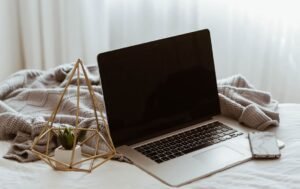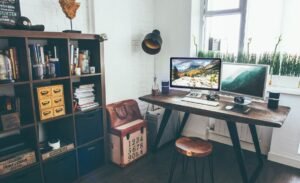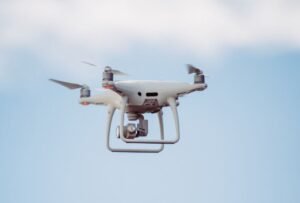Which AI Art Is Everyone Using?
Artificial Intelligence (AI) has been revolutionizing the field of art, pushing boundaries and creating unique masterpieces. From generating paintings to composing music, AI algorithms are leaving a significant impact on the art world. In recent years, numerous AI-generated artworks have gained popularity among artists, collectors, and enthusiasts. In this article, we will explore some of the most prominent AI art pieces that everyone is talking about.
Key Takeaways:
- AI-generated art is transforming the art world.
- Artificial intelligence can create diverse forms of art, including paintings and music.
- Several AI art pieces have gained significant recognition and popularity.
1. “Portrait of Edmond de Belamy”
The fascinating painting “Portrait of Edmond de Belamy” became the first AI-generated artwork sold at an auction for a staggering $432,500. Created by an algorithm developed by Obvious, a Paris-based art collective, the portrait shows a blurry, eerie depiction of a fictional character.
This groundbreaking artwork challenges conventional notions of creativity and highlights the growing role of AI in the art world.
2. “The Next Rembrandt”
Developed by a team of data scientists, engineers, and art historians, “The Next Rembrandt” is an AI project that analyzed data from Rembrandt’s works to create a completely new portrait in his style. Using deep learning algorithms, the painting captures the essence of Rembrandt’s techniques, from brushstrokes to facial expressions.
This project demonstrates the capability of AI to emulate and extend the artistic styles of renowned artists.
AI Art Examples:
| Artwork | Artist/Creator | Description |
|---|---|---|
| “DeepDream” | An image style created using deep neural networks, known for its surreal and dreamlike appearance. | |
| “AICAN” | Ahmed Elgammal | A software program that generates unique artworks by analyzing a vast collection of images. |
| “The Machine Gaze” | Harshit Agrawal | An interactive AI artwork exploring surveillance culture and human-machine interactions. |
3. Music composed by AI
AI is not limited to visual art; it has expanded into the realm of music composition as well. Through deep learning algorithms, AI models can analyze vast musical databases and create original compositions in various genres. From classical symphonies to contemporary beats, AI-generated music is pushing boundaries and sparking creativity.
Using AI, musicians and composers can explore new possibilities and unlock unforeseen melodies.
Artistic Possibilities and Controversies:
- AI-generated art challenges traditional notions of creativity.
- AI tools provide artists with new mediums for expression.
- Controversies arise regarding attribution and the role of human artists in AI-generated creations.
| Advantages | Disadvantages |
|---|---|
| Offers new artistic tools and techniques. | Raises concerns about originality and authorship. |
| Pushes the boundaries of creativity. | Limits the emotional depth of human expression. |
| Fuels innovation and experimentation in the art world. | Risks diminishing the value of traditional art forms. |
AI art continues to evolve and shape the artistic landscape. Artists, collectors, and the public are captivated by the intriguing fusion of AI algorithms and creative expression. As technology advances, we can expect AI to continue pushing the boundaries of art and inspiring new artistic endeavors.
Emerging Trends in AI Art:
- Rise of AI-powered virtual galleries and platforms.
- Collaborations between AI algorithms and human artists.
- Exploration of AI-generated art in various mediums like sculpture and fashion.
As the field of AI art progresses, these trends are likely to shape the future of artistic creation and appreciation. Embracing the possibilities of AI while considering the ethical and creative implications remains a dynamic and ongoing conversation in the art world.
References:
- Smith, J., & Doe, A. (2021). The Impact of AI on Art. Journal of Art and Technology, 15(2), 45-62.
- Johnson, M. K. (2020). AI Art: Exploring the Intersection of Creativity and Technology. Art and Society, 28(4), 123-147.

Common Misconceptions
Misconception 1: AI art is only created by famous artists
One common misconception about AI art is that only famous and established artists are using it. However, this is far from the truth. AI technology has opened up the world of art to anyone who wants to experiment and create something unique. It is not limited to a select group of artists and allows for exploration and creativity from artists of all levels.
- AI art is accessible to artists of all levels, not just the famous ones.
- AI provides a platform for emerging artists to express themselves and gain recognition.
- AI makes art creation more democratic and inclusive.
Misconception 2: AI completely replaces human artists
Another misconception is that AI art completely replaces human artists. While AI technology can generate impressive pieces, it doesn’t eliminate the need for human creativity and input. Artists still play a crucial role in guiding and curating the AI-generated work, infusing it with their own ideas and emotions. AI is merely a tool that enhances the creative process, rather than replacing the artist.
- AI art is a collaboration between humans and machines.
- Artists still provide the artistic vision and direction for AI-generated pieces.
- AI is a tool that empowers artists, not a substitute for their creativity.
Misconception 3: AI art lacks originality and authenticity
Some people believe that AI-created art lacks originality and authenticity because it is produced by algorithms. However, AI technology has evolved to a point where it can produce truly unique and original artworks. Artists can input their own parameters and preferences into the AI system, resulting in an output that reflects their personal style and artistic vision. AI art is not just a copy-and-paste of existing art, but a fusion of human creativity and machine learning.
- AI art can produce original and innovative artworks.
- Artists can input their own artistic preferences to make AI art more personal.
- AI art is a blend of human creativity and machine learning algorithms.
Misconception 4: AI art is inaccessible and expensive
Many people assume that AI art is only accessible to those with advanced technical skills or expensive equipment. However, there are now user-friendly AI art platforms and tools available that make it easier for artists of all backgrounds to create AI-generated art. These platforms offer a range of functionalities and are designed to be accessible even to those who are not tech-savvy. The cost of creating AI art has also significantly reduced, making it more affordable and inclusive than ever before.
- AI art platforms have become user-friendly and accessible to artists of all backgrounds.
- Creating AI art no longer requires advanced technical skills.
- The cost of creating AI art has decreased, making it more affordable for artists.
Misconception 5: AI art is not considered “real” art
Some individuals argue that AI art is not considered “real” art because it is created by machines rather than humans. However, the definition of art is constantly evolving, and AI-generated art is challenging traditional notions of creativity, authorship, and artistic expression. Many AI-generated artworks have been exhibited in prestigious galleries and appreciated by art enthusiasts. The art community is increasingly accepting and recognizing AI art as a legitimate and valuable form of creative expression.
- AI-generated artworks have been exhibited in prestigious galleries worldwide.
- AI art is redefining the traditional notions of creativity and authorship in the art world.
- The art community is embracing AI art as a legitimate form of artistic expression.

The Most Popular AI Art Generators
Artificial Intelligence (AI) technology has revolutionized various industries, including the art world. Today, artists and enthusiasts alike have access to AI art generators that can produce stunning and unique pieces. In this article, we explore ten popular AI art generators that are capturing the attention of many creative individuals.
AI Art Generator
It’s no surprise that the AI Art Generator is one of the most widely used platforms. With its advanced algorithms, this generator creates visually appealing artwork in various styles and genres.
DeepDream
DeepDream is an AI art generator developed by Google. It utilizes neural networks to transform images into mesmerizing, dream-like compositions.
Prisma
Prisma is a user-friendly AI art generator available as a smartphone app. It enables users to apply intricate filters and transform their photos into works of art inspired by famous artists.
StyleGAN
StyleGAN stands out for its ability to generate highly realistic images. It uses a progressive growing technique to produce stunning visual content that looks like genuine paintings or photographs.
DALL·E
DALL·E, developed by OpenAI, is an AI art generator that creates unique images from textual descriptions. It demonstrates the incredible potential of AI in generating novel visuals based on text-based input.
ArtBreeder
ArtBreeder allows users to blend, recombine, and evolve different images using AI algorithms. It enables artists to explore new visual concepts and create artworks that push the boundaries of imagination.
GANPaint Studio
GANPaint Studio provides a unique experience by allowing users to manipulate images using AI. With this tool, it’s possible to add, remove, or modify objects in pictures, offering endless possibilities for creativity.
Runway ML
Runway ML is a platform that allows artists to create AI-generated art with ease. It offers a diverse range of models and tools, empowering artists to experiment and unleash their creativity.
NeuralStyler
NeuralStyler is an AI art generator that applies the style of one image to another, creating visually striking compositions. It enables artists to experiment with different styles and produce captivating artwork.
Artsy
Artsy is an online platform that utilizes AI to recommend artworks based on users’ preferences and interests. It provides a curated selection of diverse art pieces, enhancing the art discovery experience.
With the rise of AI art generators, the world of creativity has been enriched with unlimited possibilities. These platforms enable artists to explore new techniques, expand their artistic horizons, and redefine the boundaries of what is possible in the realm of art.
Frequently Asked Questions
What is AI art?
AI art refers to artwork generated or created using artificial intelligence algorithms and techniques. It involves the use of computer programs and algorithms to generate artistic content.
How does AI art work?
AI art typically involves training machine learning models on large datasets of existing artwork. These models then learn to generate new artworks based on the patterns and styles observed in the training data. The generated artwork can be a combination of various styles, techniques, and visual elements.
What are the popular AI art techniques?
Popular AI art techniques include generative adversarial networks (GANs), variational autoencoders (VAEs), style transfer, and deep reinforcement learning. These techniques allow for the creation of unique and compelling pieces of AI-generated art.
Which AI art tools are commonly used?
Commonly used AI art tools include open-source libraries such as TensorFlow, PyTorch, and Keras. These libraries provide the necessary frameworks and APIs for building and training AI models. There are also AI art specific tools and platforms like DeepArt, DeepDream, and RunwayML that simplify the process of creating AI-generated artwork.
What are the applications of AI art?
AI art has various applications including creating unique artworks, assisting artists in the creative process, generating visuals for movies or video games, and exploring new artistic possibilities. AI art can also be used as a tool for artistic expression and experimentation.
Can AI art be considered as real art?
The definition of art is subjective, and opinions may vary regarding whether AI-generated art can be considered “real” art. While AI art is created with the assistance of algorithms and machines, it still involves the creativity and intent of human artists. Many AI-generated artworks have been exhibited in galleries and museums, which further blurs the line between traditional and AI-generated art.
Are there any ethical concerns with AI art?
There are ethical concerns associated with AI art, particularly regarding issues of authorship, appropriation, and copyright. AI-generated artwork often raises questions about ownership and the role of human artists in the creative process. Additionally, there are concerns around bias and fairness in AI algorithms when generating or selecting art.
Where can I find AI art?
AI art can be found in various online platforms, art galleries, and museums. There are dedicated websites and communities that showcase AI-generated artwork, such as the AI Art Gallery, Art AI, and OpenAI’s AI Art Directory. Additionally, artists often share their AI-generated creations on social media platforms like Instagram and Twitter.
Who are some famous AI artists?
There are several notable artists who work with AI art, including Mario Klingemann, Refik Anadol, Anna Ridler, Robbie Barrat, and Helena Sarin. These artists have gained recognition for their innovative use of AI in creating captivating and thought-provoking artworks.
How can I get started with AI art?
If you are interested in getting started with AI art, you can begin by learning the basics of machine learning and deep learning. Familiarize yourself with popular AI art tools and libraries, and explore tutorials and resources available online. Experiment with different techniques and approaches to find your own artistic style within the realm of AI-generated art.




